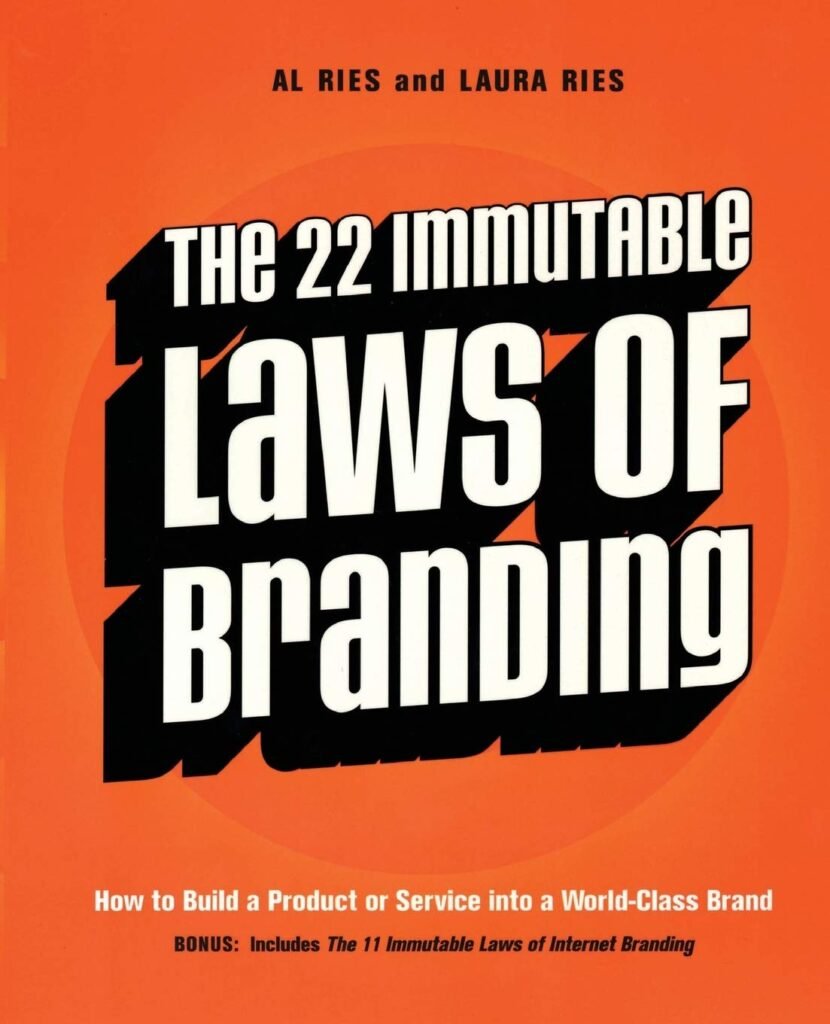Have you ever wondered what truly makes a brand successful? “The 22 Immutable Laws of Branding Paperback – September 1, 2002” by Al Ries and Laura Ries might just have the answers you’re looking for.

Overview of “The 22 Immutable Laws of Branding”
“The 22 Immutable Laws of Branding” provides essential strategies for building successful brands. Written by renowned marketing experts Al Ries and Laura Ries, this book outlines 22 key principles that anyone interested in branding must know and understand. By following these laws, you can create a powerful brand identity that stands the test of time.
Why Branding is Important
Branding isn’t just a logo or a catchy tagline. It’s the perception people have about your product or service. A strong brand builds trust, recognition, and loyalty among your customers. It distinguishes you from competitors and makes you stand out in a crowded marketplace. The principles in this book help you develop a brand that resonates with your audience, ensuring consistent growth and longevity.
Benefits of Strong Branding:
| Benefit | Description |
|---|---|
| Trust | Builds customer confidence in your product |
| Recognition | Makes your brand easily identifiable |
| Loyalty | Encourages repeat business and word-of-mouth referrals |
| Competitive Edge | Differentiates you from competitors |
Detailed Breakdown of the 22 Laws
Each law in the book is a cornerstone for building a robust branding strategy. Here, we’ll go through each one to give you a comprehensive understanding of what each law entails.
1. The Law of Expansion
The more you expand your brand, the weaker it becomes. This principle emphasizes the importance of focus. Stick to what you do best and avoid the temptation to stretch your brand too thin. It can dilute your brand identity and confuse your customers.
2. The Law of Contraction
Just as expansion can weaken a brand, contraction can strengthen it. Focusing narrowly on a particular niche enables you to become a strong leader in that specific category. It allows you to target your marketing efforts more effectively and build a loyal customer base.
3. The Law of Publicity
A brand is not built by advertising but by publicity. Public relations (PR) can be far more effective in establishing a brand because it generates credibility. This law highlights the importance of newsworthiness and the role of the press in building a brand.
4. The Law of Advertising
Once a brand is established, it needs continued advertising to stay relevant. Advertising is essential for maintaining brand awareness and reaching new customers. Consistent advertising efforts help you stay top-of-mind among your audience.
5. The Law of the Word
A brand should own a word in the mind of the consumer. This single word should encapsulate the unique selling proposition (USP) of your brand. Whether it’s “fast,” “reliable,” or “innovative,” owning a word helps you occupy a unique space in the consumer’s mind.
6. The Law of Credentials
The crucial factor in the success of a brand is its claim to authenticity. Being perceived as the genuine article in your specialty builds a strong, trustworthy brand. Credentials add credibility and can be leveraged during PR and advertising campaigns.
7. The Law of Quality
While an important factor, quality alone won’t build a brand. It has to be supplemented with effective marketing strategies and brand positioning. Simply relying on quality isn’t enough; how you communicate your quality matters more.
8. The Law of the Category
If you can’t be first in a category, create a new category you can be first in. This law encourages innovation and differentiation, helping you establish a unique position in the market. Being first in a new category helps you become synonymous with that category.
9. The Law of the Name
Choosing the right brand name is crucial. It should be easy to remember, spell, and pronounce. A good name can reinforce your marketing message and should ideally be short and relevant to your product or service.
10. The Law of Extensions
Brand extensions can dilute your main brand and confuse customers. While extending your brand into new markets or products might seem like a good idea, it can lead to a lack of focus. This law advises caution in brand extension strategies.
11. The Law of Fellowship
Sometimes, the best way to grow is to allow competitors to thrive in your category. Competition can be beneficial as it validates the need for your category, encouraging customer interest and expanding the market as a whole.
12. The Law of the Generic
Generic names fail to differentiate a brand. They can make it difficult for consumers to remember and find your brand. The law advises against using generic names and encourages uniqueness and creativity.
13. The Law of Company
Brands are brands, and companies are companies. There should be a clear distinction between the two. This separation helps maintain the integrity of each and avoids confusion in the marketplace.
14. The Law of Subbrands
Subbrands seldom work as intended. Instead of creating a subbrand, focus on strengthening your primary brand. This law suggests that subbrands often confuse customers and dilute the parent brand.
15. The Law of Siblings
This law is about managing multiple brands within the same company. Each brand should be distinct and targeted at a different market segment. When properly managed, multiple brands can coexist without cannibalizing each other’s market share.
16. The Law of Shape
A brand’s logo or symbol should be simple, memorable, and adaptable. This helps in creating a visually impactful brand that is easily recognizable across different media and platforms.
17. The Law of Color
Color plays a significant role in brand recognition and differentiation. It’s advisable to use a color that stands out from your competitors and is inherently linked to your brand identity.
18. The Law of Borders
A brand should know no borders. In the age of globalization, it’s essential for brands to think beyond their domestic markets. This law encourages brands to consider international expansion while maintaining their core values and identity.
19. The Law of Consistency
Consistency in brand messaging and customer experience builds trust and recognition. This law emphasizes the need for a cohesive brand strategy that remains constant across all touchpoints.
20. The Law of Change
Brands must evolve to stay relevant, but the changes should align with core brand values. This law advises caution: change should be gradual and well-considered, ensuring it doesn’t disrupt the established brand identity.
21. The Law of Mortality
No brand lives forever. It’s important to recognize when a brand’s lifecycle is coming to an end and to handle the transition gracefully. This law prepares you for the eventual decline of a brand and advises on how to manage it.
22. The Law of Singularity
In the final analysis, a brand must be unique. This law sums up the essence of all the other laws by emphasizing the need for uniqueness and differentiation in branding.

Lessons from “The 22 Immutable Laws of Branding”
The wisdom packed into “The 22 Immutable Laws of Branding” extends beyond marketing professionals to anyone who makes decisions about a company’s product or service. Here’s what you can learn:
Focus on Core Competencies
Specialization makes you formidable in your chosen field. Trying to be everything to everyone can water down your effectiveness. Stick to your strengths, and you’ll find it easier to dominate your market.
Importance of Public Relations
Advertising is critical, but it’s merely a tool for maintaining awareness. Publicity, on the other hand, establishes credibility and can act as a catalyst for brand recognition.
Owning a Word
Owning a specific word in the consumer’s mind not only simplifies your marketing efforts but also makes your brand unforgettable.
Practical Applications
Applying these laws can significantly benefit your branding strategy. Let’s look at some real-world applications of these principles.
Re-evaluating Brand Extensions
Before launching a new product under your existing brand, ask yourself: Does this fit with our core identity? Is it true to our original focus? If not, you might want to rethink the extension to avoid diluting your brand.
Leveraging PR for Brand Building
Consider crafting newsworthy stories about your brand that media outlets will want to cover. Engaging in community events, new product launches, or charitable activities can generate valuable publicity.
Simplifying Your Brand Name
If your brand name is complicated or doesn’t resonate with your audience, think about simplifying it. A simpler, more memorable name can significantly boost your brand’s effectiveness.
Using the Right Color
Audit your brand’s visual identity. Are your brand colors distinct from your competition? Do they evoke the right emotions? Adjust colors if necessary to ensure they align with your brand’s personality and stand out in the market.
Frequently Asked Questions (FAQs)
Does the book only apply to large brands?
No, the principles in “The 22 Immutable Laws of Branding” apply to brands of all sizes. Whether you’re a small business or a large corporation, these laws offer invaluable guidelines for building and maintaining a strong brand.
Can startups benefit from this book?
Absolutely! Startups can gain a lot from this book as it helps them establish a solid foundation right from the beginning. Focusing on these laws can help avoid common pitfalls and set the stage for sustainable growth.
Is it only for marketers?
While the book is a treasure trove for marketers, anyone involved in building or managing a brand, including business owners and senior executives, will find the principles highly beneficial.
How quickly can I expect results?
Brand building is a long-term investment. While some results like improved recognition or customer trust can be observed relatively quickly, establishing a strong brand typically takes time and consistent effort.
Conclusion
“The 22 Immutable Laws of Branding Paperback – September 1, 2002” is a comprehensive guide that offers timeless wisdom on building and managing a successful brand. By applying these 22 principles, you can create a brand that resonates deeply with your audience, stands out in the marketplace, and enjoys long-term success. Whether you’re a startup, a small business, or a large corporation, this book provides actionable insights that can transform the way you approach branding. Happy branding!
Disclosure: As an Amazon Associate, I earn from qualifying purchases.


